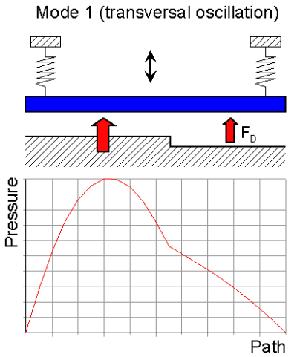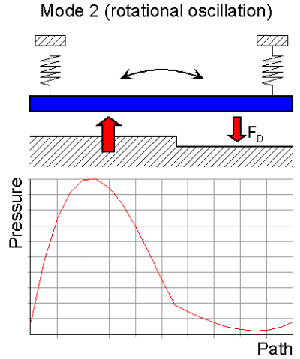The basic steps in performing the analysis are as follows:
Build a structural and thin-film fluid model and mesh.
Perform a modal analysis on the structure.
Extract the desired mode eigenvectors.
Select the desired modes for damping parameter calculations.
Perform a harmonic analysis on the thin-film elements.
Compute the modal squeeze stiffness and damping parameters.
Compute modal damping ratio and squeeze stiffness coefficient.
Display the results.
Steps 4-7 have been automated using the DMPEXT command macro. Step 8 is available through the MDPLOT command macro.
Model preparation for the modal projection method for damping parameter extraction follows very closely to the method outlined in Modeling and Meshing Considerations. Both the structural model and the thin-film fluid model need to be defined simultaneously. Group the fluid nodes on the structure surface into a node component named "FLUN". This component should only include nodes attached to FLUID136 elements. This component defines the nodes for which the eigenvector values will be extracted from the mode-frequency analysis.
A modal analysis of the structure is required to obtain the eigenvectors of the desired modes. The modal analysis should be set up with the following options:
The expanded eigenmodes will compute the necessary eigenvectors required for the modal projection technique. Note: The thin-film fluid elements may be left active in the model when performing the modal analysis. These elements will not contribute to the modal solution.
The eigenvectors from the modal analysis must be retrieved and stored in a format appropriate for use by the thin-film fluid elements for a subsequent harmonic fluid analysis. Use the RMFLVEC command in POST1 to retrieve the eigenvectors. The data is stored in the file Jobname.EFL.
The command macro DMPEXT performs a harmonic analysis with the thin-film fluid elements using the eigenvector information for the desired mode(s). The macro also extracts damping parameter information for use in subsequent dynamic structural analysis. Damping parameters extracted include the modal damping coefficient, modal squeeze stiffness coefficient, damping ratio, and the squeeze-to-stiffness ratio.
DMPEXT requires a "source" mode number and a "target" mode number. The source mode is the mode for which the eigenvectors are used to impart a velocity field on the fluid elements. The target mode is the mode which is acted on by the pressure solution (fluid forces). For transverse oscillations and a uniform gap, there is little mode interaction and hence only diagonal terms are required (source mode (i) = target mode (j)). For transverse motion with nonuniform gaps, or asymmetric plate motion, mode interaction effects (cross-talk) can be significant and should be computed (source mode .ne. target mode). Typical cross-talk scenarios are shown in Figure 4.3: Fluidic Cross-Talk between Transverse and Rotational Motion.
Damping parameter extraction can be selected over a desired frequency range or at the eigenfrequencies of the structure. Damping results are computed and stored in an array parameter.
Computed damping ratios may be used in subsequent dynamic structural analyses. A damping ratio can be applied using DMPRAT for a subsequent harmonic or mode-superposition transient analysis. Mode damping ratios may be applied using the MDAMP command for use in mode-superposition harmonic and transient analyses. Note: Subsequent structural analysis using these damping parameters do not require the thin-film fluid elements in the model.
The command macro ABEXTRACT (like DMPEXT) extracts alpha and beta damping parameters for use in the ALPHAD and BETAD commands. These commands define Rayleigh damping and can be used in time-transient structural analysis to model damping effects. The damping parameters are computed from two modes defined by the user.
The command macro MDPLOT may be used to display the frequency-dependent damping parameters.




